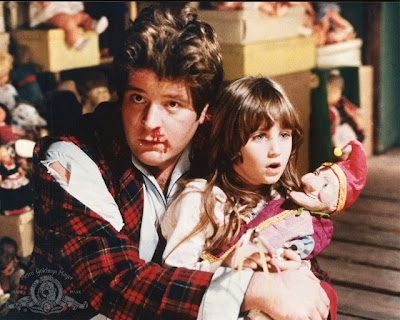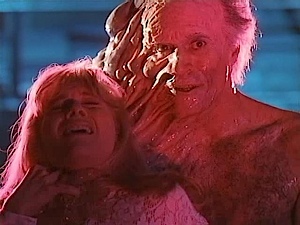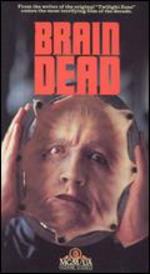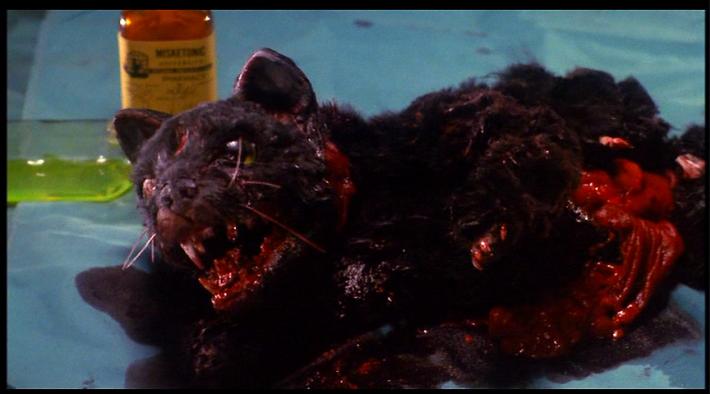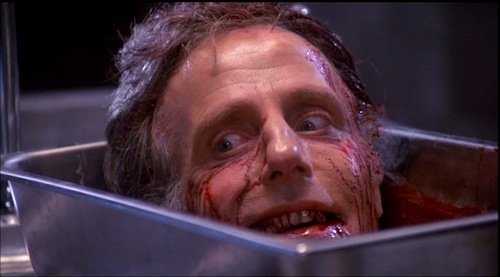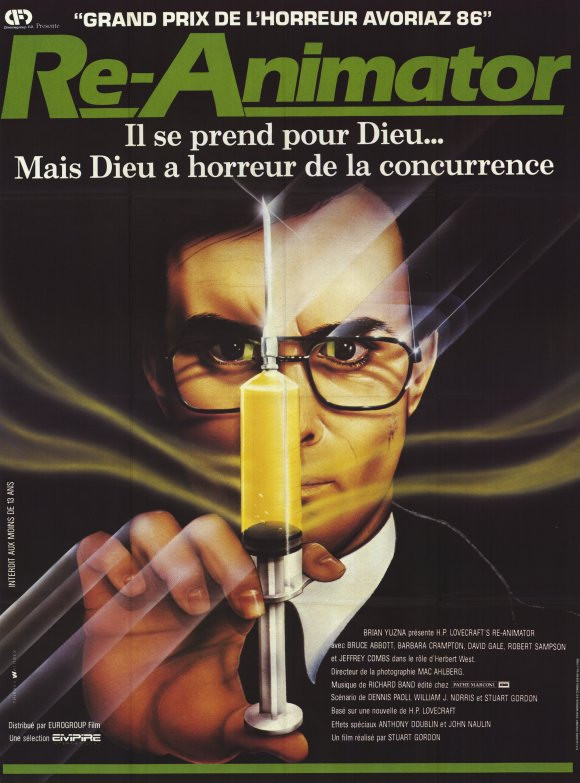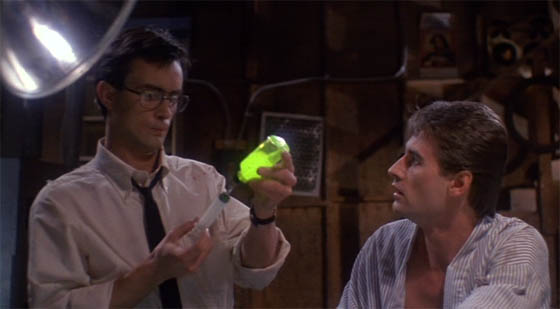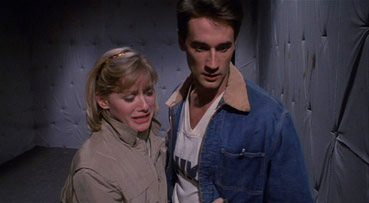catch up on Re-Animator HERE
and From Beyond HERE,
if you missed them.
Up until now, I had never seen Dolls (1987) before and I'm not sure why. I've seen it on the shelves at the video store for years, I'm aware of who made it, and what the premise was. . .but maybe that's the problem. Personally, I'm not a big fan of the killer doll/puppet sub-genre of horror films. I know they have their fans and supporters, etc., but for me creepy dolls work better when they are just part of a film, like the clown doll in Poltergeist (1982) or that mannequin in Deep Red (1975) or that creepy fucker in that one Spanish movie I saw that one time (Satan's Blood [1978]), rather than when they're the main villain or threat. Movies like Child's Play (1988) or Puppetmaster (1989) have decent concepts, but they seem to stumble in execution. The base concept of a killer doll is scary, but in practice I usually find myself wondering why anybody would run from a little thing like that and just not, you know, kick it away and smash it or whatever. I mean, it's little, it can't have that much body strength. I guess Dolls goes a little way in covering this by having an army of killer toys running around. Harder to squish when there's dozens of them. Of course, maybe I'm over-thinking the legitimacies of a concept involving dolls that happen to be living...
Let's talk about the movie instead.
Dolls has a classic horror movie opening, where a family is traveling the countryside and they get caught in a rain storm, the kind of storm in horror movies that forces people to pull over (in this case, the car gets stuck) and spend the night at a stranger's house. Young Judy (Carrie Lorraine) is on a trip with her father David (Ian Patrick Williams) and evil stepmother Rosemary (Carolyn Purdy-Gordon), when they find themselves in this scenario and they seek refuge in a creepy old, gothic mansion, yet another convention of horror movies. The occupants of the old mansion are an elderly couple, Gabriel and Hilary Hartwicke (Guy Rolfe and Hilary Mason), who greet their unexpected visitors kindly, especially Judy. They are joined by yet another group of stranded travelers, who literally barge into the house, consisting of good-hearted doofus Ralph (Stephen Lee) and the two British punk rocker girls, Isabel (Bunty Bailey) and Enid (Cassie Stuart), that he picked up hitchhiking.
The house is populated by a bounty of (you guessed it) dolls, most of them those weird porcelain type dolls that you'd see at flea-markets or at your grandmother's. Judy and Ralph take an interest in them, Judy because she's a little girl, Ralph because he seems to be "young at heart," as they say. Everyone else seems to go out of their way to be unpleasant and obnoxious. Judy's dad is a real jerk who is a bit of a gold digger and treats Judy as if she's a burden. His new bride Rosemary is one of those snide, fashionable bitches, who bluntly states that they "could be in Monte Carlo now, if it wasn't for the twerp." The punk rock girls aren't much better, revealing themselves to be thieves, first planning on robbing Ralph, then stealing some of the antiques (or "ann-tikis") from the mansion. This leads to their undoing, as the dolls seem to be vindictive against anybody without a kind or innocent spirit (which is why Judy and Ralph are safe, more or less).
The dolls use weapons, like knives and hammers, and they also have sharp little razor teeth. There's even a set of toy soldiers that have working rifles! The special effects are a combination of puppetry and mechanical effects with the occasional bit of stop motion work. When not seen, the dolls can be heard skittering and scurrying about on the floor making little chattering, squeaky noises, which I found annoying rather than creepy.
The effects are sometimes goofy looking, but the murders are entertaining and clever enough, with a couple cool transformation scenes. Rosemary's death and the discovery of her body is a particularly gruesome scene, as is the Teddy attack scene, which is one of best in the movie, even though it doesn't really happen.
After the family's car gets stuck and they're walking to the creepy mansion, Rosemary pulls a bitch move on Judy and throws her teddy bear (Teddy) out into the woods, saying that it'll just "slow her down." Judy has an overactive imagination, and she imagines Teddy emerging from the woods, the size of a real bear, and he sheds off his teddy bear skin, revealing a terrifying bear monster underneath. Teddy then proceeds to maul dad and rip Rosemary's arm off. When done, Judy just shakes her head and says, "oh, Teddy," and then Teddy just shrugs his shoulders. It's kind of a funny idea, this kid having such violent daydreams, and I like the image of a teddy bear that turns into a giant monster better than I do killer dolls running around all over the place. A character called "Grizzly Teddy" in the movie Demonic Toys (1992, also produced by Charles Band) seems to be directly inspired by Teddy.
The plot to Dolls is bare bones, the running time a brisk 77 minutes, and the ending a little anti-climatic and unsatisfying. Ralph and Judy wake up from being knocked out and Gabriel tells them it was all just a dream. He reads them a letter from Judy's dad saying that they've left and that she should go back and live with her mother back in the city. Ralph asks about the hitchhikers and Gabriel quickly adds, "oh yeah, and we dropped off the hitchhikers," before throwing the note into the fire. Ralph and Judy then drive off, Judy having ideas that Ralph will marry her mother. It's an abrupt ending, almost childlike in its simplistically, like a fairy tale. Supposedly at one time Stuart Gordon had a notion of doing a sequel, involving the dolls in the city, but it never came to fruition.
The acting in Dolls is a mixed bag, the punk rock girls being the worst of the bunch. In general, everyone seems to go BIG and broad with their performances, but given the fairy tale-like nature of the story, this might be excusable. The movie has a very knowing sense of humor, fully aware of what kind of story this is. At one point, Ralph is simultaneously mistaken for a murderer by Enid and a pervert by Judy's dad. Later, when Judy's father calls Hilary a witch, meaning it as a slur, she replies to Gabriel, "he's figured it out."
Judy's dad David is quite the jerk and he gets quite the comeuppance at films end in the movie's best surprise. Ian Patrick Williams was a member of Stuart Gordon's theater company in Chicago, Illinois. He would have a small role in Re-Animator as a Swiss doctor, and would also star in Robot Jox (1989) and King of the Ants (2003), as well as the cult favorite horror flick TerrorVision (1986). He's also done a lot of guest star work on TV, everything from Seinfeld and ER to Dexter and Modern Family.
Carolyn Purdy-Gordon is one of the more enjoyable aspects of this movie, just oozing a despicable nature. She plays a cold bitch rather well and Stuart Gordon usually finds a place for her in his movies somewhere. She has starred in eight of her husband's thirteen films, usually (but not always) getting killed off in some grizzly manner. For some reason, she wears a head wrap constantly during Dolls.
Carrie Lorraine as little Judy is a decent child actress, balancing that line of cute innocence and annoying platitudes. Lorraine would not pursue an acting career after Dolls and today she is a lawyer for criminal defense in Los Angeles.
Ralph is maybe the most enjoyable character in the movie, just a kind hearted goof. Stephen Lee would return to star in Gordon's The Pit and the Pendulum (1991), and would also have small roles in WarGames (1983) and Robocop 2 (1990). He would also portray the Big Bopper in La Bamba (1987).
Guy Rolfe brings a certain pleasant creepiness to Gabriel the weird old toy maker, giving him a niceness, despite his wicked tendencies. In addition to playing the title character in William Castle's Mr. Sardonicus (1961), Guy Rolfe would play another master of puppets, Andre Toulon, in Puppet Master III-V (1991/93/94), as well as reprising the role in Retro Puppet Master (1999), which I bet you didn't even know existed.
Old lady alert: Hilary Mason was the blind psychic woman in Nicolas Roeg's Don't Look Now (1973).
Total 80s alert: Bunty Bailey, who played punker Isabel, was in Ah-ha's classic music video for "Take On Me." Her grizzly fate in Dolls is (kinda) portrayed on the video cover.
Dolls was actually filmed directly after Re-Animator, but not released until two years later, after From Beyond, due to the post-production time on the stop motion animation effects. Made in Italy, it has a much more Italian feel than From Beyond does (which was also filmed in Italy, using some of the same sets). Returning crew members from previous Stuart Gordon films include cinematographer Mac Ahlberg, editor Lee Percy, producer Brian Yuzna, and special effects maestro John Carl Buechler. Total 80s alert: Bunty Bailey, who played punker Isabel, was in Ah-ha's classic music video for "Take On Me." Her grizzly fate in Dolls is (kinda) portrayed on the video cover.
The writer of the film is Ed Naha, who wrote Troll (1986), C.H.U.D. II (1989), and Dollman (1991), and also co-scripted Honey, I Shrunk the Kids (1989), based on a story by himself, Stuart Gordon, and Brian Yuzna. Interestingly enough, his most recent screenplay credits are for new religious epics The Ten Commandments (2007) and Noah's Ark: A New Beginning (2012).
Executive producer Charles Band's studio Empire Pictures would eventually collapse due to massive debt a couple years after the release of Dolls. Band would move from Rome back the The States and open a new studio, Full Moon Entertainment, where he would produce and release a slew of direct to video trash, such as the Subspecies movies, the Trancers sequels (the original being an Empire release), and the Puppet Master and Demonic Toys franchises, those later two being directly inspired by Dolls.
This is the weakest of Stuart Gordon's early horror films, but Dolls is light entertainment and there's some fun to be had, if you think this would be your kind of thing. After Dolls, Gordon would shoot the giant robot movie Robot Jox, a movie I know I saw (back in the day) and was actually excited to rent a copy of. Might have to revisit that one sometime soon... It's also been forever since I've seen Castle Freak (1995) and I've never seen his take on The Pit and the Pendulum. I've also not seen some of his most recent films, like Edmond (2005), starring William H. Macy or Stuck (2007), with Stephen Rea and Mena Suvari. Seems like I'll be having a Round 2 of Stuart Gordon appreciation week at some point in the future. Stay tuned...












